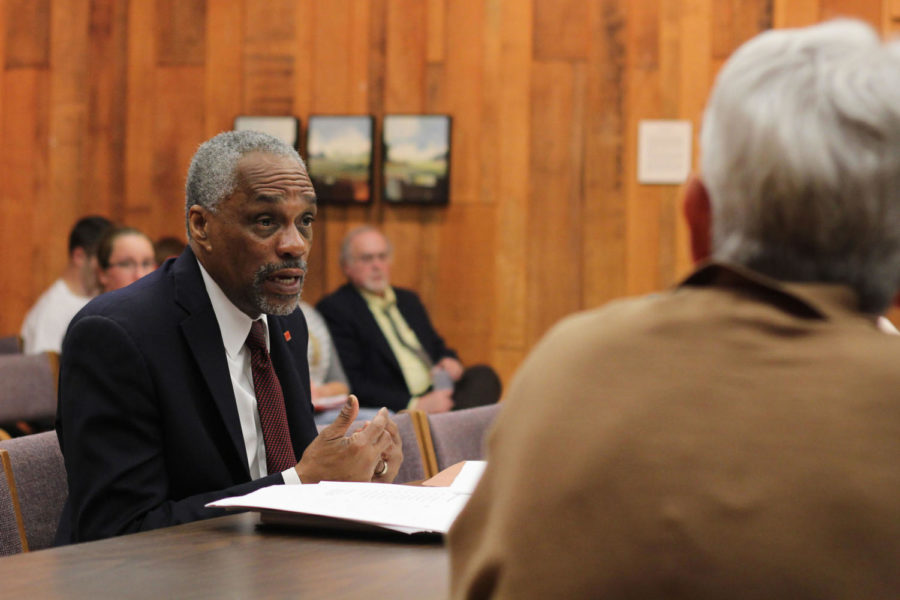Ethiraj: Task force needs to refocus on underlying cause of riots
Miranda Cantrell/Iowa State Daily
Senior vice president of student affairs Tom Hill addresses the Veishea Task Force during the force’s first open meeting in the Pioneer Room of the Memorial Union on April 24. The task force plans to hold a series of open forums at which students and community members can voice their concerns and impart information related to the Veishea riot.
June 18, 2014
The Veishea Task Force made some major decisions in the last two meetings. The members voted to discontinue Veishea in its current form June 5 and took a nonbinding vote June 12 to move forward without the name Veishea.
Though these decisions help the task force move forward in a direction toward its recommendation, I do not believe that these will help solve the problem we are facing.
Looking at the data, the 1992 standoff between the crowd and the police occurred when the officers subdued and carried away an individual for public intoxication on Welch Avenue after he resisted arrest. In 2004, a similar standoff occurred when the police decided to “close” a large party of approximately 400 people at the corner of Chamberlain and Hunt streets. Likewise in 2014, officers went to break up another large party in the 2600 block of Hunt Street whose participants, like in previous years’ confrontations, headed toward Welch Avenue and Chamberlain Street, eventually forming a large crowd
Therefore, Veishea — as we know it — had nothing to do with any of these. So instead of unanimously voting to discontinue Veishea in its current form, could the task force have voted to discontinue the approach officers take when they confront house parties? Could it brainstorm ideas to better handle the dispersal of crowds after breaking up parties?
I agree that there is a party mindset among students when it comes to Veishea. But one needs to understand that partying is different from rioting.
“Parties are one thing that are kept inside — in porches or patios,” said Micheal Owen, university professor and a task force member who has lived on the south side of campus for 25 years.
Looking at the Veishea 2014 program, one could see that Veishea in its current form does not propagate or encourage partying even in controlled environments. It is heavily invested in showcasing the university and student talent show events combined with some entertainment.
The whole binding decision to discontinue Veishea in its current form does not address or prevent the underlying cause of the riot.
The task force has also been discussing whether or not we need big concerts and evening entertainment as part of the new overarching event that will replace Veishea.
“The [riots] happened on a night when there were no large events” said Hillary Kletscher, Government of the Student Body president. “Big-name artists draw in 10,000 to 12,000 students while smaller events draw in 50 to 500 students.”
“Veishea entertainment email was read by over 15,000 students, which shows they care about [Veishea],” said Nick Morton, Veishea 2014 co-chairman.
On top of that, organizing these events “[provides] students an opportunity for positive social interaction” and “[provides] opportunities for the development of student leadership,” as per the “Nine Traditional Purposes of Veishea” that were compiled more than two decades ago.
Given the enormous evidence, a majority of the task force members still have an aversion to evening entertainment.
But regardless of continuing the evening entertainment or not, this discussion does not address the underlying cause of the riot.
Finally, the task force discussed and decided to vote on whether or not we need the name Veishea. What saddens me is that this passed with a vote of 12-3-1 to move forward without the name, thereby choosing to kill the 92-year-old tradition.
There is still a possibility the decision could be overturned; since the vote was nonbinding, the task force could revisit this decision. But according to Dwayne Vande Krol, ISU alumnus and 2009-10 ISU alumni board chairman, “If this group unanimously voted to get rid of the name, then it would take something very compelling to revisit this decision.” While the vote was not unanimous, it was close to it, so a reversal doesn’t seem likely.
Making a decision on whether or not to keep Veishea as the name still does not deal with the riot problem, which is the reason the task force was formed, yet the task force discussed, brainstormed and voted on these decisions.
Craig Anderson, distinguished professor of psychology, said that students would still associate partying with this new, but fundamentally similar, celebration.
With only two meetings left, the task force is still in its infancy in planning the “new overarching event” that will replace Veishea. It still has yet to address the role, relevance and appropriateness of “other university-wide celebrations for the future,” which is what President Steven Leath charged it to do.
So why is the task force trying to fix things that are not broken and completely unrelated to the riots when it is running out of time?
Is it about time we all ask what the Veishea Task Force is really doing.

















